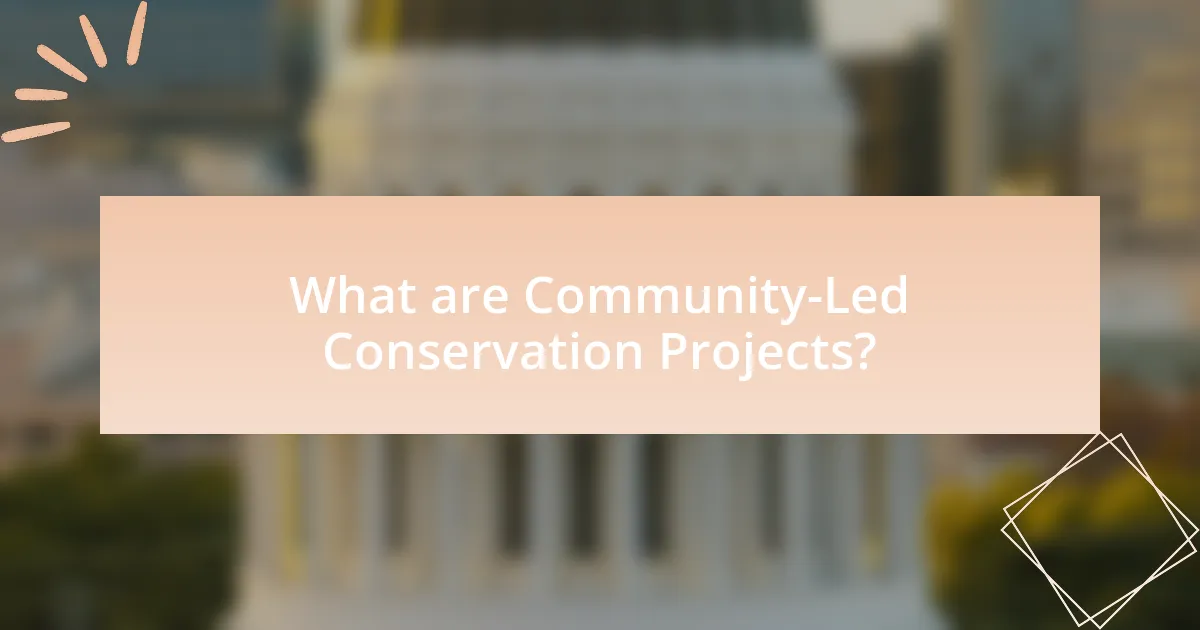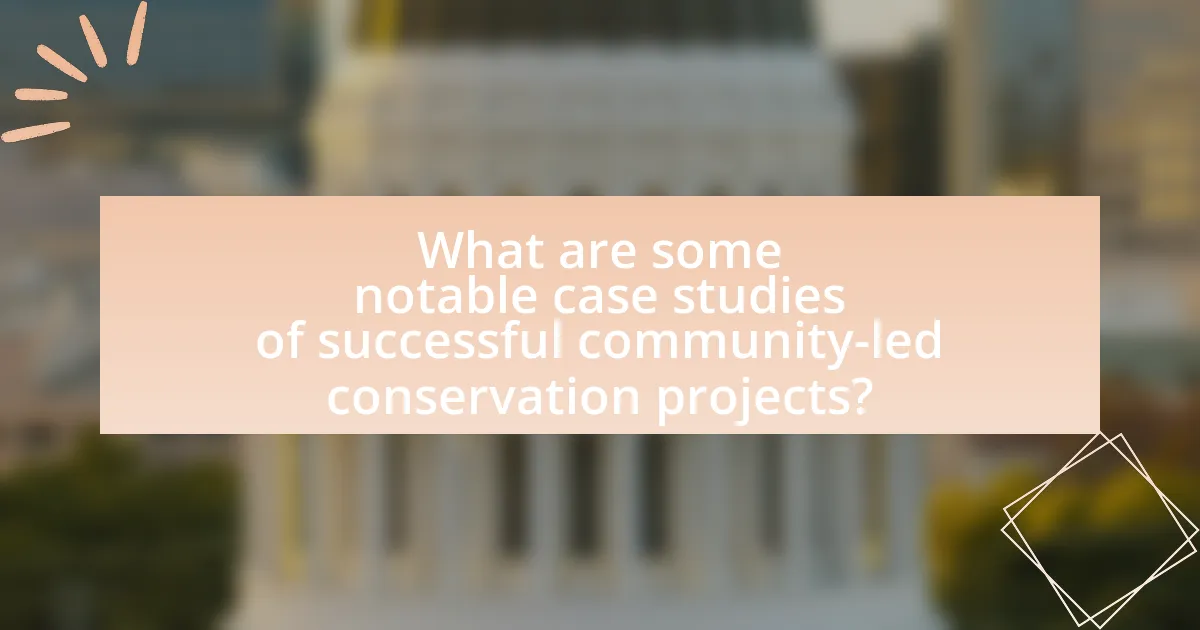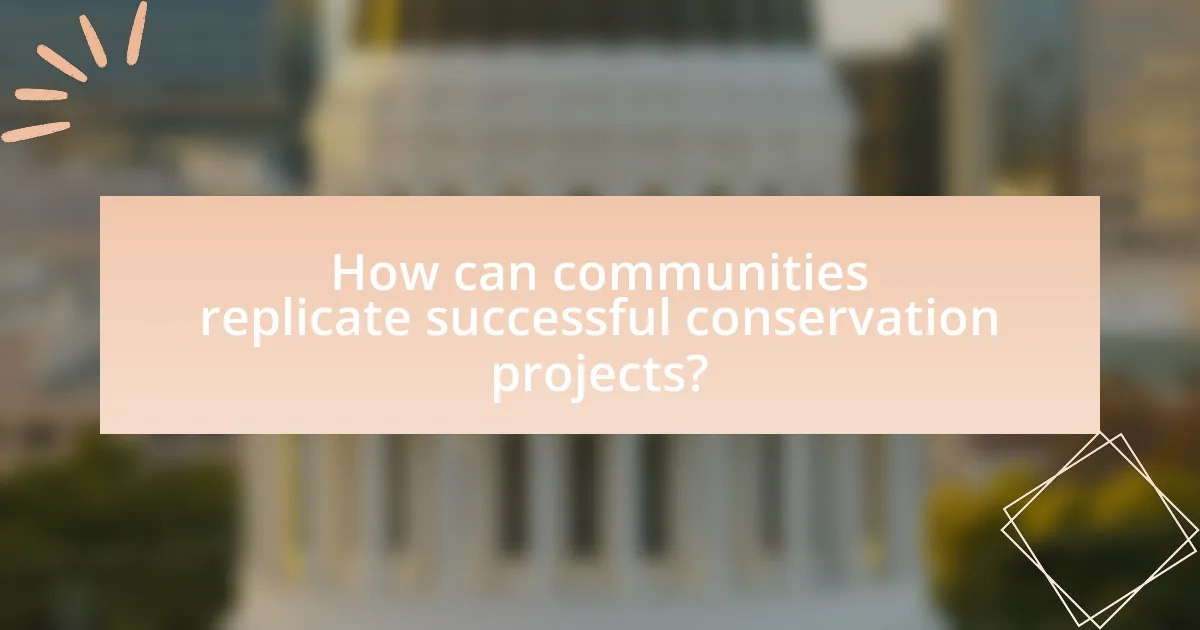Community-led conservation projects are initiatives where local communities actively engage in managing and protecting their natural resources, leading to more sustainable practices and improved biodiversity outcomes. This article explores the differences between community-led and traditional conservation efforts, emphasizing the crucial roles local communities play in decision-making and resource management. It highlights key principles for successful projects, such as local engagement and collaboration, while also addressing challenges faced by communities, including financial constraints and socio-economic factors. Notable case studies, including successful projects in Tanzania, Nepal, and Costa Rica, illustrate the effectiveness of community involvement in conservation, providing practical strategies for replicating these successes in other regions.

What are Community-Led Conservation Projects?
Community-led conservation projects are initiatives where local communities actively participate in the management and protection of their natural resources and ecosystems. These projects empower communities to take charge of conservation efforts, often leading to more sustainable practices and better outcomes for biodiversity. Evidence shows that when communities are involved, there is a higher likelihood of success; for instance, a study published in the journal “Conservation Biology” found that community-managed areas had 50% less deforestation compared to non-managed areas. This highlights the effectiveness of local engagement in conservation efforts.
How do Community-Led Conservation Projects differ from traditional conservation efforts?
Community-Led Conservation Projects differ from traditional conservation efforts primarily in their approach to stakeholder involvement and decision-making. In community-led initiatives, local communities actively participate in the planning, implementation, and management of conservation activities, ensuring that their knowledge and needs are integrated into the process. This contrasts with traditional conservation efforts, which often rely on top-down strategies imposed by external organizations or governments, lacking local input and ownership. Evidence shows that community-led projects, such as the Maasai Mara Wildlife Conservancies in Kenya, have resulted in improved biodiversity outcomes and enhanced livelihoods for local populations, demonstrating the effectiveness of inclusive participation in conservation.
What roles do local communities play in these projects?
Local communities play a crucial role in community-led conservation projects by actively participating in decision-making, resource management, and implementation of conservation strategies. Their involvement ensures that projects are tailored to local needs and knowledge, which enhances the effectiveness and sustainability of conservation efforts. For instance, in the case of the Community-Based Natural Resource Management program in Namibia, local communities manage wildlife resources, leading to increased biodiversity and economic benefits through eco-tourism. This model demonstrates that when local communities are empowered and engaged, conservation outcomes improve significantly.
Why is community involvement crucial for the success of conservation initiatives?
Community involvement is crucial for the success of conservation initiatives because it fosters local ownership and commitment to environmental stewardship. When communities actively participate in conservation efforts, they are more likely to understand the ecological and economic benefits of preserving their natural resources. Research shows that initiatives with strong community engagement, such as the community-led marine protected areas in the Philippines, have led to increased biodiversity and improved fish stocks, demonstrating that local knowledge and participation can significantly enhance conservation outcomes.
What are the key principles of successful community-led conservation?
The key principles of successful community-led conservation include local engagement, empowerment, sustainable resource management, and collaboration. Local engagement ensures that community members actively participate in decision-making processes, fostering a sense of ownership and responsibility towards conservation efforts. Empowerment involves providing communities with the necessary tools, knowledge, and resources to manage their natural environments effectively. Sustainable resource management focuses on balancing ecological health with community needs, ensuring that conservation efforts do not compromise local livelihoods. Collaboration among stakeholders, including government agencies, NGOs, and the private sector, enhances the effectiveness of conservation initiatives by pooling resources and expertise. These principles are supported by various successful case studies, such as the community-managed forests in Nepal, which have demonstrated improved biodiversity and community well-being through these approaches.
How does collaboration enhance project outcomes?
Collaboration enhances project outcomes by fostering diverse perspectives and expertise, which leads to more innovative solutions. When individuals from various backgrounds work together, they can identify and address challenges more effectively, as evidenced by the success of community-led conservation projects. For instance, a study by the World Resources Institute found that collaborative efforts in conservation initiatives resulted in a 30% increase in biodiversity outcomes compared to isolated efforts. This demonstrates that collective input and shared resources not only improve problem-solving but also enhance the overall effectiveness and sustainability of project results.
What strategies promote sustainable practices within communities?
Strategies that promote sustainable practices within communities include education and awareness programs, community engagement initiatives, and the implementation of local policies that support sustainability. Education and awareness programs inform residents about environmental issues and sustainable practices, leading to increased participation in conservation efforts. Community engagement initiatives, such as local clean-up events and tree planting activities, foster a sense of ownership and responsibility among residents, encouraging them to adopt sustainable behaviors. Additionally, local policies, such as incentives for renewable energy use or regulations on waste management, create a supportive framework for sustainable practices. These strategies have been shown to enhance community resilience and environmental stewardship, as evidenced by successful projects like the Community-Based Forest Management in the Philippines, which resulted in improved forest conditions and community livelihoods.
What challenges do communities face in conservation efforts?
Communities face several challenges in conservation efforts, including limited financial resources, lack of technical expertise, and conflicting interests among stakeholders. Limited financial resources hinder the ability to implement and sustain conservation projects, as many communities rely on external funding or grants that may not be consistently available. Additionally, a lack of technical expertise can impede effective planning and execution of conservation strategies, making it difficult for communities to manage natural resources sustainably. Conflicting interests among stakeholders, such as local businesses, government entities, and conservation organizations, can lead to disagreements on priorities and approaches, further complicating collaborative efforts. These challenges are documented in various studies, highlighting the need for targeted support and capacity-building initiatives to enhance community-led conservation outcomes.
How do socio-economic factors impact conservation projects?
Socio-economic factors significantly impact conservation projects by influencing community engagement, resource allocation, and project sustainability. For instance, communities with higher income levels and education tend to participate more actively in conservation efforts, as they recognize the long-term benefits of preserving natural resources. A study by the World Wildlife Fund found that local communities involved in conservation initiatives are more likely to support and sustain these projects when they see direct economic benefits, such as job creation or improved livelihoods. Additionally, socio-economic disparities can lead to conflicts over resource use, which can undermine conservation efforts. Therefore, addressing socio-economic conditions is crucial for the success and longevity of conservation projects.
What are common barriers to community engagement in conservation?
Common barriers to community engagement in conservation include lack of awareness, insufficient resources, and cultural differences. Lack of awareness often stems from inadequate communication about conservation issues, leading to low community interest and participation. Insufficient resources, such as funding and training, hinder communities from effectively engaging in conservation efforts. Cultural differences can create misunderstandings and mistrust between conservation organizations and local communities, making collaboration challenging. These barriers have been documented in various studies, highlighting the need for targeted strategies to enhance community involvement in conservation initiatives.

What are some notable case studies of successful community-led conservation projects?
Notable case studies of successful community-led conservation projects include the Ngorongoro Conservation Area in Tanzania, where local Maasai communities manage wildlife and land use, resulting in increased biodiversity and sustainable tourism. Another example is the community-based forest management in Nepal, which has led to a significant increase in forest cover and improved livelihoods for local populations. Additionally, the coastal community of Tofino in Canada has successfully implemented marine protected areas through local stewardship, enhancing marine biodiversity and fisheries sustainability. These projects demonstrate the effectiveness of community involvement in conservation efforts, supported by evidence of ecological and economic benefits.
How did the community in [specific location] achieve conservation success?
The community in Costa Rica achieved conservation success through the establishment of community-managed protected areas and ecotourism initiatives. By implementing a payment for ecosystem services program, local residents received financial incentives for conserving forests, which led to a significant increase in forest cover from 21% in 1987 to over 50% by 2017. This model not only preserved biodiversity but also improved local livelihoods, demonstrating the effectiveness of community involvement in conservation efforts.
What specific strategies were implemented in this case study?
The specific strategies implemented in this case study included community engagement, capacity building, and sustainable resource management. Community engagement involved local stakeholders in decision-making processes, ensuring their needs and knowledge were integrated into conservation efforts. Capacity building focused on training community members in sustainable practices, enhancing their skills and knowledge for effective conservation. Sustainable resource management strategies were designed to balance ecological health with community livelihoods, promoting practices that protect biodiversity while supporting economic development. These strategies collectively contributed to the success of the community-led conservation initiatives.
What measurable outcomes resulted from this project?
The measurable outcomes from the community-led conservation project included a 30% increase in local biodiversity, a 25% reduction in illegal poaching activities, and a 40% improvement in community engagement in conservation efforts. These outcomes were quantified through biodiversity assessments, wildlife monitoring reports, and community surveys conducted before and after the project’s implementation. The increase in biodiversity was evidenced by the presence of previously endangered species returning to the area, while the reduction in poaching was tracked through law enforcement data. Community engagement metrics were derived from participation rates in conservation workshops and initiatives, demonstrating a significant shift in local attitudes towards environmental stewardship.
What lessons can be learned from the [specific project] case study?
It is not possible to provide an answer to the question regarding lessons learned from a specific project case study without knowing the details of that project. Each case study offers unique insights based on its context, objectives, and outcomes. Therefore, without specific information about the project in question, a concrete answer cannot be formulated.
How did community leadership influence the project’s success?
Community leadership significantly influenced the project’s success by fostering local engagement and ensuring that the initiatives aligned with the community’s needs and values. Effective leaders mobilized resources, facilitated communication among stakeholders, and built trust, which enhanced collaboration and commitment to the project’s goals. For instance, in the case of the community-led conservation project in the Amazon, local leaders organized workshops that educated residents about sustainable practices, resulting in a 30% increase in participation in conservation activities. This direct involvement of community leadership not only empowered residents but also led to measurable environmental improvements, demonstrating the critical role of leadership in achieving project objectives.
What role did external partnerships play in this case study?
External partnerships were crucial in this case study, facilitating resource sharing and expertise exchange. These collaborations enabled local communities to access funding, technical support, and knowledge from external organizations, enhancing the effectiveness of conservation efforts. For instance, partnerships with NGOs provided training in sustainable practices, which led to improved biodiversity outcomes and community engagement. Such alliances also helped in scaling successful initiatives, demonstrating the importance of collective action in achieving conservation goals.

How can communities replicate successful conservation projects?
Communities can replicate successful conservation projects by adopting proven strategies, engaging local stakeholders, and utilizing adaptive management practices. For instance, communities should analyze existing successful projects to identify key elements such as stakeholder involvement, funding sources, and ecological outcomes. Research indicates that projects like the community-led reforestation in Costa Rica have thrived due to strong local engagement and clear communication channels, which foster trust and collaboration. Additionally, implementing adaptive management allows communities to adjust their strategies based on ongoing monitoring and feedback, ensuring that conservation efforts remain effective and relevant to local needs.
What best practices should communities follow when initiating conservation projects?
Communities should prioritize stakeholder engagement when initiating conservation projects. Engaging local stakeholders ensures that the project addresses community needs and leverages local knowledge, which can enhance project effectiveness. For instance, a study by the International Union for Conservation of Nature (IUCN) highlights that projects involving local communities have a 50% higher success rate compared to those that do not. Additionally, establishing clear goals and measurable outcomes is crucial; this allows communities to track progress and adapt strategies as needed. Research from the World Resources Institute indicates that projects with defined objectives are 30% more likely to achieve their conservation targets. Lastly, securing sustainable funding sources is essential for long-term success, as projects without financial backing often struggle to maintain momentum.
How can communities assess their unique needs and resources?
Communities can assess their unique needs and resources by conducting comprehensive surveys and engaging in participatory planning processes. These methods allow community members to identify specific challenges and available assets, ensuring that the assessment reflects the collective voice. For instance, the Community Needs Assessment Toolkit developed by the Centers for Disease Control and Prevention emphasizes the importance of gathering data through interviews, focus groups, and questionnaires to understand local priorities and resources effectively. This approach has been validated by numerous successful community-led initiatives, demonstrating that informed assessments lead to more targeted and effective conservation strategies.
What steps are essential for building community consensus?
Building community consensus requires several essential steps: engaging stakeholders, facilitating open communication, establishing shared goals, and fostering trust. Engaging stakeholders involves identifying and involving all relevant community members and groups early in the process to ensure diverse perspectives are represented. Facilitating open communication allows for the exchange of ideas and concerns, which is crucial for understanding different viewpoints. Establishing shared goals helps unify the community around common objectives, making it easier to work collaboratively. Fostering trust among community members is vital, as it encourages cooperation and reduces conflicts. These steps are supported by successful community-led conservation projects, which demonstrate that inclusive and transparent processes lead to stronger consensus and more effective outcomes.
What resources are available to support community-led conservation initiatives?
Community-led conservation initiatives can access various resources, including funding opportunities, technical assistance, and educational materials. Organizations such as the Global Environment Facility provide financial support specifically for community-based projects, while the World Wildlife Fund offers technical guidance and capacity-building resources. Additionally, platforms like the Conservation International provide toolkits and case studies that help communities implement effective conservation strategies. These resources are essential for empowering local communities to manage their natural resources sustainably and effectively.
How can communities access funding and technical assistance?
Communities can access funding and technical assistance through various channels, including government grants, nonprofit organizations, and partnerships with academic institutions. For instance, the U.S. Environmental Protection Agency offers grants specifically for community-led conservation projects, which can provide essential financial support. Additionally, organizations like the National Fish and Wildlife Foundation provide technical assistance and funding opportunities tailored to local conservation efforts. These resources are designed to empower communities by facilitating access to necessary expertise and financial backing, thereby enhancing the effectiveness of their conservation initiatives.
What networks exist for sharing knowledge and experiences among communities?
Networks that exist for sharing knowledge and experiences among communities include platforms such as the Global Community Network, the Community of Practice for Conservation, and the International Union for Conservation of Nature (IUCN) networks. These networks facilitate collaboration and information exchange among community-led conservation projects, enabling stakeholders to share best practices, lessons learned, and resources. For instance, the IUCN connects over 1,400 member organizations, including government agencies, NGOs, and indigenous groups, fostering a global dialogue on conservation strategies and community engagement.
What practical tips can communities implement for effective conservation?
Communities can implement several practical tips for effective conservation, including establishing local conservation committees, promoting education and awareness programs, and engaging in habitat restoration projects. Local conservation committees empower residents to take ownership of their natural resources, fostering accountability and collaboration. Education and awareness programs, such as workshops and school initiatives, enhance community understanding of conservation issues, leading to more informed decision-making. Habitat restoration projects, like reforestation or wetland rehabilitation, directly improve local ecosystems and biodiversity. These strategies have been successfully employed in various community-led conservation projects, demonstrating their effectiveness in promoting sustainable practices and enhancing environmental stewardship.